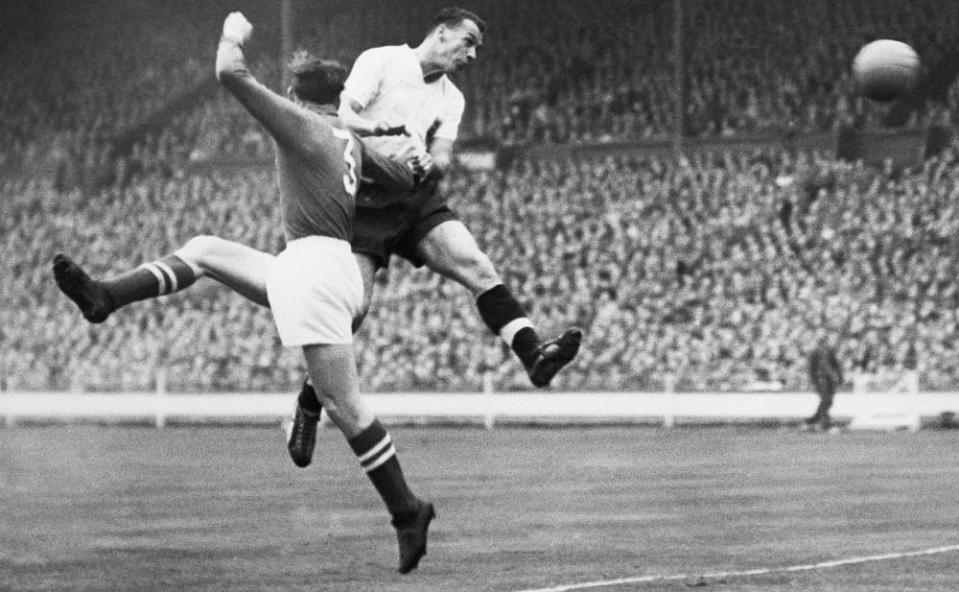Have the outfield players of a team ever had to wear goalkeeper kits?

“Have the outfield players of a team ever had to wear goalkeeper kits before?” asks Rudy.
Yes they have, Rudy, and in recent years, too. “In 2009-10, Hibernian had a white away strip which wasn’t able to be used at Celtic Park and so they played in the club’s black goalkeeper tops,” writes Denis Hurley. “And in a less dramatic example, this season Everton used orange socks from their goalkeeper kit with their black away shirts and shorts against Huddersfield in the League Cup.”

This rare quirk has been witnessed in Germany, too. Here’s Paul Vickers: “It happened in August 2019 when Stuttgart drew 2-2 with Heidenheim,” he recalls. “It seems that Stuttgart had not yet launched their third kit, and both their home and away shirts would have clashed with Heidenheim’s red and white stripes. So they went with the black home goalkeeper kit with a mint stripe.”
And if we turn the question around, Bernd Leno was forced to wear an outfield Arsenal away shirt in November last year to avoid a clash of lime green jerseys with then-Wolves goalkeeper, Rui Patrício. Premier League rules state keepers have to wear different colours, in case they venture into the opposition box in a late desperate attempt to score.
❄️ A new look for #ARSWOL
@Bernd_Leno will be wearing our away kit in goal for the first time today 🤍— Arsenal (@Arsenal) November 29, 2020
Perhaps inspired by this event, Arsenal released their yellow away jersey this season as a top that is an option for both goalkeepers and outfield players. Leno wore it against Chelsea in August and the outfield players have worn it on numerous occasions (obviously not at the same time).

Even longer-serving one-club stalwarts
Last week we discovered that Fred Blankemeijer served Feyenoord for 70 years – a period of time we assumed couldn’t be matched or bettered. We were wrong …
Mason Mondry tweets: “I’m surprised you left out Ken Friar at Arsenal. He joined the box office as a 12-year-old in 1950 and retired 70 years later as a board member in 2020.” Chris Hodge reckons it is actually 74, “if you count the four years before that when he was employed as a part-time messenger on match days after he was caught retrieving a football from under then manager George Allison’s car”.
Ross Flock, meanwhile, points us in the direction of Bolton’s record goalscorer, Nat Lofthouse, who “joined Bolton in 1939, and served the club in some capacity until his death in 2011”. Our own digging reveals a career as an apprentice, first-team player, assistant manager, chief coach, manager, chief scout, administrative manager, executive manager and president at Wanderers. There’s not much Lofthouse didn’t do in a one-club career spanning an incredible 72 years.

The Legia Warsaw legend Lucjan Brychczy is not far behind Lofthouse and Friar, and is still serving the Polish club at the age of 87, having signed for them as a 20-year-old. “He joined Legia as a player in 1954, and has been an ever-present figure since then, serving as player (until 1972), coach, assistant manager, and manager,” reports Michal Kramar. “Back in 1957, Barcelona picked Legia to play a showpiece game for the opening of Camp Nou; for a variety of political reasons Legia travelled to Barcelona and played as the ‘Warsaw team’ and Brychczy scored the opener in a game which finished 4-2 to Barça. He might have left for Milan or Real Madrid, but the communist regime meant the chances of a transfer were non-existent.”
Who are the champions of double-digit defeats?
“The unfortunate Vale of Leithen in the Scottish Lowland League lost their last two games 13-0 and 11-0 to Bonnyrigg Rose and Berwick Rangers, respectively,” writes Billy. “Have any senior teams lost three or more games to double-digit scorelines?”
Eran Rabl has found a run of double-digit defeats so bad we might just have to stand back and applaud. “Maccabi Pardes Katz, who play in Israel’s Liga Gimel (fifth tier), lost 12 consecutive matches between 14 February 2020 and 2 April 2021. The run started midway through the 2019-20 season with an 11-1 defeat by Beitar Ezra and was followed by scores of 13-0 (to Bnei Yehud), 10-2 (Tzafririm Holon), 17-0 (FC Ru’ah) and 26-0 (Hapoel Ramat Israel) before the season was cut short due to Covid-19. Then the team started the 2020-21 season with another seven defeats: 11-0 (Inter Aliyah), 20-0 (Hapoel Neveh Golan), 10-0 (Beitar Jaffa), 20-2 (Elitzur Yehud), 12-1 (Maccabi HaShikma Hen), 11-0 (HaMakhtesh Givatayim) and 12-0 (Inter Aliyah again). The streak was broken when the team lost its next match just 5-2.”
Knowledge archive
“I looked at the Bundesliga table recently and noticed three of the teams have a ‘1’ at the start of their name: 1.FC Kaiserslautern, 1.FC Köln and 1.FC Nürnberg,” mused Frankie Lowe in November 2010. “I can understand numbers in titles such as 1860 Munich and 1899 Hoffenheim, which clearly denote the year the club was formed, but unless the teams mentioned above are older than I thought then I am completely stumped. Can you help?”
“This is all explained excellently in the first chapter of the book Tor! The Story of German Football by Ulrich Hesse-Lichtenberger,” wrote Matias Pasch. “He explains all sorts of Bundesliga naming conventions that confuse foreign fans (if the oldest football club in the world is Notts County, vintage 1862, how can there be a German football club named TSV München von 1860?). Regarding the 1. he mentions 1. FC Nürnberg: ‘The first football club in Nürnberg.’ Indeed, when using the whole name of such a club one says ‘Erste FC Kaiserslautern’, or ‘First FC Kaiserslautern’. All the clubs mentioned are nominally the first football clubs of their respective cities, thus they carry a ‘1.’ in their name.”
Can you help?
We were pointed towards this question being asked by Adam Hurrey. Perhaps you kind Knowledge readers can help him:
All I want to know is: Has a team with 8 men ever scored (let alone *equalised*) against 11 men before? pic.twitter.com/wUzVbwGnrQ
— Adam Hurrey (@FootballCliches) October 25, 2021
“In the 1929-30 season, Brentford won all 21 home games,” writes David Daniels. “Has any other club achieved this feat, either domestically or abroad?”
On 30th Sep Smalling and Abraham both scored for Roma in a European tie vs Zorya Luhansk. How many times has more than 1 English (or even British) player scored for a European/Non-British club in a European competition (UCL, UEFA cup, etc)?
— Kenn Rushworth (@14Autumns) October 26, 2021
“James Rodríguez has now played for eight clubs, each in a different country. Can any other player match this feat of globetrotting whilst limiting themselves to just one club per nation played in?” asks Jonathan Lucas.
Post-Moscow heroics, Daka was on the bench for Leicester at West Ham. In Sept Brentford's Forss was unused sub the game after scoring four, while Rodriguez got injured after four for Burnley. Is this the longest run of four-goal cup hauls not followed by starts in any one league?
— stuart goodwin (@stuartgoodwin) October 26, 2021
“In a recent local GAA match in Ireland, 14 of the matchday squad of one team had the same surname (O’Sullivan). What is the highest number of players to appear on a football pitch with the same surname?” wonders James Sheedy.
What’s the most northern and, inversely, most southern the Premier League has ever been in a single season? (Maybe calculated by the northern-most and southern-most mean location of all PL grounds for that year?)
— Will Sharp (@shillwarp) October 26, 2021
• Mail us your questions or tweet @TheKnowledge_GU.

 Yahoo Movies
Yahoo Movies 
